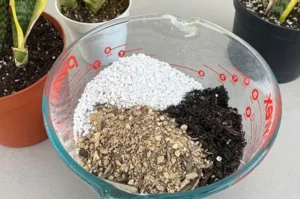Snake plants, also known as Sansevieria, are loved for their upright, architectural leaves and ability to thrive in low-light conditions. Over time, however, these leaves can collect dust, water spots, and residue, leaving them looking dull. Fortunately, making snake plant leaves shiny is simple with the right techniques and care practices.
In this guide, you’ll learn safe, natural, and effective methods to restore and maintain the shine on your snake plant leaves while keeping your plant healthy.
How to Make Snake Plant Leaves Shiny:
To make snake plant leaves shiny, gently wipe them with a soft, damp microfiber cloth to remove dust and residue. For added shine, lightly apply a diluted mixture of coconut oil or neem oil using a cloth. Avoid chemical leaf shine sprays, and maintain ideal indoor humidity and lighting conditions to keep the leaves healthy and glossy.
What Causes Snake Plant Leaves to Look Dull?
A few factors can make your snake plant’s leaves lose their natural sheen:
- Dust accumulation
- Water spots and hard water residue
- Pests like mealybugs or spider mites
- Dry indoor air or improper humidity
- Low-quality plant care products
The first step to bringing back their shine is addressing these underlying issues.
How to Make Snake Plant Leaves Shiny (Step-by-Step)
1. Clean the Leaves Regularly
The easiest way to restore shine is by wiping the leaves clean. Dust and dirt settle on the leaf surface, blocking light and dulling their appearance.
To clean your snake plant leaves:
- Use a soft, damp microfiber cloth.
- Gently wipe each leaf from base to tip.
- Avoid harsh fabrics like paper towels, which can scratch the surface.
2. Use Natural, Plant-Safe Leaf Shiners
Avoid using chemical-based commercial leaf shine sprays, as these can clog the tiny pores (stomata) on the leaves. Instead, opt for natural methods that enhance shine and promote plant health.
a) Coconut Oil (Lightly Diluted)
A light application of coconut oil can create a subtle, healthy shine while protecting against pests and fungal issues. Mix a drop of coconut oil with water and gently wipe it onto the leaves using a soft cloth.
If you don’t have coconut oil handy, you can find organic, cold-pressed coconut oil ideal for indoor plant care here on Amazon.
b) Neem Oil Solution
Neem oil is a natural leaf shiner and pest repellent. Mix 1-2 drops of neem oil with water in a spray bottle, lightly mist the leaves, and wipe them with a soft cloth. It restores sheen and prevents issues like mealybugs and spider mites.
I personally recommend using a cold-pressed neem oil like this one available on Amazon, as it’s 100% pure and safe for houseplants.
c) Banana Peel Wipe
Rubbing the inner side of a banana peel along your snake plant’s leaves removes dust and deposits a natural wax-like layer, enhancing shine naturally. This old-school plant care trick works best when leaves are already clean.
3. Maintain Ideal Humidity and Lighting
Snake plants thrive in moderate humidity and indirect, bright light. Dry, stale indoor air can make leaves look dull and lifeless.
To improve the humidity around your plant:
- Place a shallow dish of water near the plant.
- Group your houseplants together.
- Use a small humidifier in the room.
If you’re looking for a reliable option, this compact indoor plant humidifier from Amazon is a good fit for houseplants without overwhelming the room.
4. Prevent and Remove Water Spots
Hard water often leaves behind calcium deposits on leaves, dulling their surface. Use filtered or distilled water when cleaning or misting your plant.
If you notice existing spots, gently wipe them off using a soft cloth dipped in a mixture of distilled water and a few drops of white vinegar (1:10 ratio). Avoid strong cleaning agents, as snake plants have sensitive leaves that can get damaged easily.
For a step-by-step breakdown on safely removing dust and water spots without harming your plant’s natural shine, I’ve shared some useful techniques in this article on cleaning snake plant leaves naturally.
5. Regular Dusting Routine
Once your snake plant leaves are clean and shiny, it’s important to maintain them. Regular dusting will prevent buildup and preserve their appearance.
- Wipe leaves once a week with a microfiber cloth.
- Gently dust in between with a soft feather duster.
A microfiber cleaning cloth set like this one on Amazon is perfect for indoor plants and delicate surfaces.
Best Practices for Shiny Snake Plant Leaves
To keep your plant looking its best:
- Avoid using baby oil or petroleum-based products.
- Don’t overapply oils or homemade leaf shiners; once a month is plenty.
- Ensure the plant gets enough indirect sunlight.
- Use filtered water for misting and cleaning.
- Check for pests regularly.
These care habits not only maintain shine but also support the plant’s natural photosynthesis process, keeping it healthy and vibrant.
Final Thoughts
Keeping your snake plant leaves clean and naturally shiny isn’t difficult; it’s all about using gentle, safe methods and establishing a simple care routine. Regular cleaning, the occasional use of coconut or neem oil, and maintaining the right indoor conditions can make a significant difference in your plant’s appearance and health.
As always, if your snake plant leaves are looking dusty, it’s wise to properly clean them before applying anything for shine. I’ve shared practical cleaning techniques you can follow here if you’d like a refresher.
Frequently Asked Questions (FAQs)
What is the best way to make snake plant leaves shiny naturally?
The best way is to wipe the leaves clean with a soft, damp cloth and occasionally apply diluted coconut oil or neem oil for a subtle shine.
Can I use commercial leaf shine sprays on snake plants?
It’s not recommended. Many commercial sprays contain silicone or petroleum-based ingredients that can clog the leaf’s pores and attract dust.
How often should I shine my snake plant leaves?
Once a month is sufficient. Over-shading can block stomata and affect the plant’s ability to breathe.







2 thoughts on “How to Make Snake Plant Leaves Shiny (Complete Guide)”
Very good tips from you all, thank you
Thanks for these tips.